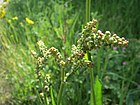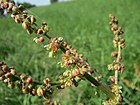Note: This is a project under development. The articles on this wiki are just being initiated and broadly incomplete. You can Help creating new pages.
Difference between revisions of "Rumex acetosella - Sheep's sorrel"
Chaithrika (talk | contribs) (+Common names) |
(→List of Ayurvedic medicine in which the herb is used) |
||
| (7 intermediate revisions by 2 users not shown) | |||
| Line 1: | Line 1: | ||
[[File:Ahosuolaheinä (Rumex acetosella).jpg|thumb|''Rumex acetosella'', ''Sheep's sorrel'']] | [[File:Ahosuolaheinä (Rumex acetosella).jpg|thumb|''Rumex acetosella'', ''Sheep's sorrel'']] | ||
| − | ''' | + | '''Rumex acetosella''' is a species of flowering plant in the buckwheat family Polygonaceae. The plant and its subspecies are common perennial weeds. |
| + | |||
| + | ==Uses== | ||
| + | {{Uses|fevers}}, {{Uses|inflammations}}, {{Uses|kidney and urinary tract diseases}}, {{Uses|intestinal parasites}}, {{Uses|eczema}}, {{Uses|herpes}}, {{Uses|itchy rashes}}, {{Uses|digestive problems}}, {{Uses|Sore throats}} | ||
| + | |||
| + | ==Parts Used== | ||
| + | {{Parts Used|Leaves}}. | ||
| + | |||
| + | ==Chemical Composition== | ||
| + | Crysophanic acid, and an iron-greening tannin. In the early stage of its growth, it abounds in oxalic acid<ref name="chemical composition"/> | ||
| + | |||
| + | ==Common names== | ||
| + | {{Common names|kn=Pundi|ml=|sa=Pundi|ta=|te=Chukkakura|hi=Chuk|en=Common Sorrel, Spinach dock}} | ||
| + | |||
| + | ==Properties== | ||
| + | Reference: Dravya - Substance, Rasa - Taste, Guna - Qualities, Veerya - Potency, Vipaka - Post-digesion effect, Karma - Pharmacological activity, Prabhava - Therepeutics. | ||
| + | ===Dravya=== | ||
| + | |||
| + | ===Rasa=== | ||
| + | Tikta (Bitter), Kashaya (Astringent) | ||
| + | ===Guna=== | ||
| + | Laghu (Light), Ruksha (Dry), Tikshna (Sharp) | ||
| + | ===Veerya=== | ||
| + | Ushna (Hot) | ||
| + | ===Vipaka=== | ||
| + | Katu (Pungent) | ||
| + | ===Karma=== | ||
| + | Kapha, Vata | ||
| + | ===Prabhava=== | ||
| + | |||
| + | ==Habit== | ||
| + | {{Habit|Herb}} | ||
| + | |||
| + | ==Identification== | ||
| + | ===Leaf=== | ||
| + | {{Leaf|Simple||Leaves are Lobed or unlobed but not separated into leaflets}}<ref name="Leaf"/> | ||
| + | |||
| + | ===Flower=== | ||
| + | {{Flower|Unisexual|2-4cm long|pink to red|six|There are two or more ways to evenly divide the flower}} | ||
| + | |||
| + | ===Fruit=== | ||
| + | {{Fruit|General|0.9–1.5 mm|The fruit is dry but does not split open when ripe|With hooked hairs|many}} | ||
| + | |||
| + | ===Other features=== | ||
| + | |||
| + | ==List of Ayurvedic medicine in which the herb is used== | ||
| + | |||
| + | ==Where to get the saplings== | ||
| + | ==Mode of Propagation== | ||
| + | {{Propagation|Seeds}}. | ||
| + | |||
| + | ==How to plant/cultivate== | ||
| + | Most gardeners consider sorrel a perennial pesky weed. It is in good company, as many medicinal plants such as dandelion, plantain, and nettle are disdained as weeds to be rooted out of garden and lawn.<ref name="How to plant/cultivate"/> | ||
| + | |||
| + | ==Commonly seen growing in areas== | ||
| + | {{Commonly seen|Heaths and acid grasslands}}, {{Commonly seen|A weed of acid soils}}, {{Commonly seen|Borders of forests and fields}}. | ||
| + | |||
| + | ==Photo Gallery== | ||
| + | <gallery class="left" caption="" widths="140px" heights="140px"> | ||
| + | 20140420Rumex acetosa1.jpg | ||
| − | |||
| − | + | 20140420Rumex acetosa2.jpg | |
| − | + | ||
| + | 20140420Rumex acetosa3.jpg | ||
| − | |||
| − | + | 20140424Rumex acetosa1.jpg | |
| − | + | ||
| + | |||
| + | 20140424Rumex acetosa2.jpg | ||
| + | |||
| + | </gallery> | ||
| + | |||
| + | ==References== | ||
| + | |||
| + | <references> | ||
| + | <ref name="chemical composition">[https://www.henriettes-herb.com/eclectic/kings/rumex-acet.html "Chemical constituents"]</ref> | ||
| − | + | <ref name="Leaf">[https://gobotany.newenglandwild.org/species/rumex/acetosella/ "plant Characteristics"]</ref> | |
| − | + | <ref name="How to plant/cultivate">[https://www.anniesremedy.com/rumex-acetosella-sheep-sorrel.php "How to Grow Sheep Sorrel"]</ref> | |
| + | </references> | ||
| − | == External Links == | + | ==External Links== |
| + | * [https://www.webmd.com/vitamins/ai/ingredientmono-718/sorrel Rumex acetosella on webmd.com] | ||
| + | * [https://jonbarron.org/herbal-library/herbs/sheep-sorrel Rumex acetosella on jon barron.org] | ||
| + | * [http://www.naturalmedicinalherbs.net/herbs/r/rumex-acetosella=sheeps-sorrel.php Rumex acetosella on natural medicinalherbs.net] | ||
| + | * [https://www.herbal-supplement-resource.com/sorrel-uses-benefits.html Rumex acetosella on herbal-supplement-resource uses and benefits] | ||
| − | |||
[[Category:Herbs]] | [[Category:Herbs]] | ||
| + | [[Category:Polygonaceae]] | ||
Latest revision as of 15:22, 12 June 2019
Rumex acetosella is a species of flowering plant in the buckwheat family Polygonaceae. The plant and its subspecies are common perennial weeds.
Contents
- 1 Uses
- 2 Parts Used
- 3 Chemical Composition
- 4 Common names
- 5 Properties
- 6 Habit
- 7 Identification
- 8 List of Ayurvedic medicine in which the herb is used
- 9 Where to get the saplings
- 10 Mode of Propagation
- 11 How to plant/cultivate
- 12 Commonly seen growing in areas
- 13 Photo Gallery
- 14 References
- 15 External Links
Uses
fevers, inflammations, kidney and urinary tract diseases, intestinal parasites, eczema, herpes, itchy rashes, digestive problems, Sore throats
Parts Used
Chemical Composition
Crysophanic acid, and an iron-greening tannin. In the early stage of its growth, it abounds in oxalic acid[1]
Common names
| Language | Common name |
|---|---|
| Kannada | Pundi |
| Hindi | Chuk |
| Malayalam | |
| Tamil | |
| Telugu | Chukkakura |
| Marathi | NA |
| Gujarathi | NA |
| Punjabi | NA |
| Kashmiri | NA |
| Sanskrit | Pundi |
| English | Common Sorrel, Spinach dock |
Properties
Reference: Dravya - Substance, Rasa - Taste, Guna - Qualities, Veerya - Potency, Vipaka - Post-digesion effect, Karma - Pharmacological activity, Prabhava - Therepeutics.
Dravya
Rasa
Tikta (Bitter), Kashaya (Astringent)
Guna
Laghu (Light), Ruksha (Dry), Tikshna (Sharp)
Veerya
Ushna (Hot)
Vipaka
Katu (Pungent)
Karma
Kapha, Vata
Prabhava
Habit
Identification
Leaf
| Kind | Shape | Feature |
|---|---|---|
| Simple | Leaves are Lobed or unlobed but not separated into leaflets |
Flower
| Type | Size | Color and composition | Stamen | More information |
|---|---|---|---|---|
| Unisexual | 2-4cm long | pink to red | six | There are two or more ways to evenly divide the flower |
Fruit
| Type | Size | Mass | Appearance | Seeds | More information |
|---|---|---|---|---|---|
| General | 0.9–1.5 mm | The fruit is dry but does not split open when ripe | With hooked hairs | many | {{{6}}} |
Other features
List of Ayurvedic medicine in which the herb is used
Where to get the saplings
Mode of Propagation
How to plant/cultivate
Most gardeners consider sorrel a perennial pesky weed. It is in good company, as many medicinal plants such as dandelion, plantain, and nettle are disdained as weeds to be rooted out of garden and lawn.[3]
Commonly seen growing in areas
Heaths and acid grasslands, A weed of acid soils, Borders of forests and fields.
Photo Gallery
References
External Links
- Ayurvedic Herbs known to be helpful to treat fevers
- Ayurvedic Herbs known to be helpful to treat inflammations
- Ayurvedic Herbs known to be helpful to treat kidney and urinary tract diseases
- Ayurvedic Herbs known to be helpful to treat intestinal parasites
- Ayurvedic Herbs known to be helpful to treat eczema
- Ayurvedic Herbs known to be helpful to treat herpes
- Ayurvedic Herbs known to be helpful to treat itchy rashes
- Ayurvedic Herbs known to be helpful to treat digestive problems
- Ayurvedic Herbs known to be helpful to treat Sore throats
- Herbs with Leaves used in medicine
- Herbs with common name in Kannada
- Herbs with common name in Hindi
- Herbs with common name in Telugu
- Herbs with common name in Sanskrit
- Herbs with common name in English
- Habit - Herb
- Index of Plants which can be propagated by Seeds
- Herbs that are commonly seen in the region of Heaths and acid grasslands
- Herbs that are commonly seen in the region of A weed of acid soils
- Herbs that are commonly seen in the region of Borders of forests and fields
- Herbs
- Polygonaceae





